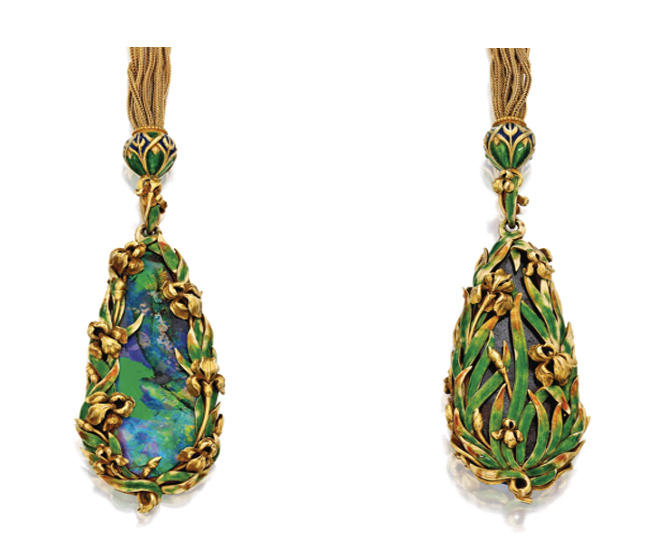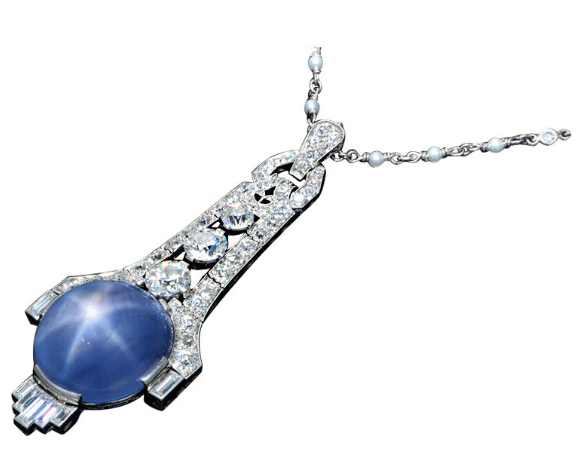A Short Introduction to the Great Early American Jewellers
When asked to name a famous American jeweller, Tiffany & Co. or Harry Winston would probably come to mind for a large number of us. However, did you know that at the turn of the 19th century, many fine jewellers were setting up shop and becoming hugely successful, sharing the same level of prestige as Tiffany's and Cartier? Some of the legendary names such as McTeigue & Co., J.E Caldwell & Co., Black, Starr & Frost, and Oscar Heyman still exist today. We pay homage to 3 of these pioneers jewellers whose pieces we currently hold in our collection.
Black Starr & Frost
One of the oldest American jewelers, Black Starr and Frost was famously sung about in Marilyn Monroe's ''Diamonds are a Girl's Best Friend'', alongside Tiffany, Cartier, Gorham and Harry Winston. In 1810, Isaac Marquand founded Marquand & Co. at 166 Broadway in New York. When the Marquand family subsequently withdrew from the business in 1839, Mr Ball and Mr Black, together with their cashier, Eratus 0. Tompkins, took over and the firm became known as Black, Ball & Co. The company received much publicity in 1851 when they displayed an exquisite 4 -piece tea service made of pure gold at the London Crystal Palace exhibition and again in 1859, when they provided $100,000 worth of diamonds and pearls to "The Diamond Wedding" between Frances Amelia Bartlett and Don Esteban Santa Crus de Oviedo. In 1860 Black, Ball & Co. were the first to build a fire-proof building in New York, also installing the modern safe deposit system in their vaults. The building was one of the finest of its time and became a cultural landmark. Cortland Starr and Aaron Frost joined as partners in 1876 and the name was amended to Black, Starr & Frost as we know today. Throughout the years, the firm catered to royal families and dignitaries from Europe and America. The Prince of Wales, the Vandebilts and Guggenheims and Carnegies were all patrons of the boutique. From 1920 - 1962, a partnership was formed between Gorham and Black, Starr & Frost and the firm was named Black, Starr & Gorham. Following their separation, Black, Starr & Frost merged with Marcus & Co. Since 2006, Black Starr & Frost has been owned by Alfredo J. Molina.
Peggy Hopkins Joyce acquired this diamond from Black, Starr & Frost by trading a $350,000 pearl necklace for the diamond and $23,000 in cash. Harry Winston acquired the Portugese Diamond in 1951 and it is currently residing in the Smithsonian Institution.
This “Mystery clock” was made in 1931 and exhibited at the 1939 World Fair. Designed by Vladimir Makovsky and made by Pierre Gravoin, it consists of platinum, 18k yellow gold, mother-of-pearl, lapis lazuli, turquoise, rock crystal, black onyx, diamond-set and emerald-set, with winding/setting key. By Vladimir Makovsky for Black, Starr & Frost.
A Platinum, Jadeite and Diamond Brooch, circa 1925 . Composed of carved jadeite plaques of foliate design, set in the centre with a marquis-shaped diamond weighing approximately .75 carats, accented by old European- cut, single-cut and window-cut diamonds weighing approximately 4.30 carats. Signed B.S.& F, for Black, Starr & Frost.
An Art Deco "Temple of Love" brooch, featuring baguette diamonds on the hinged doors. It was offered by Christies's as Lot 204 in a New York sale in October 2001. By Black, Starr & Frost.
Designed as an openwork rose, single and old mine-cut diamond shield-shaped plaque of foliate motif, set with a baroque pearl, and enhanced by platinum cannetille work, suspending a baroque pearl, with a rose and old mine-cut diamond foliate cap, by similarly-set links, mounted in platinum, circa 1910. Signed B.S.&F. for Black, Starr & Frost
A Rare Victorian Emerald and Diamond Pendant Brooch, created in 1880 by Black, Starr & Frost.
The "Tree of Knowledge of Good and Evil". A Unique Art Deco Clock, inspired by the biblical account of The Garden of Eden, includes two lapis lazuli rams, a rock crystal river, and mother of pearl inlaid with creatures. Displayed at the 1939 World Fair and offered as Lot 229 for sale at Sotheby's in a New York sale, titled "Magnificent Jewels" in April 2002. It is now in the permanent Black, Starr & Frost museum collection. By Black, Starr & Frost.
Marcus & Co.
Herman Marcus was born and bred in Germany. Prior to moving to New York, he had worked at Ellemeyer, court jewellers of Dresden. He easily found work with both Black, Ball & Co. and Tiffany & Co. upon reaching New York and quickly became a well respected jeweller in New York. Before starting Marcus & Co. in 1892, Herman Marcus briefly partnered with Black Starr & Frost.
When Marcus and Co. opened in 1892, the artistry and skill of the jewellery house was unrivalled. The firm was prolific in their creation of Art Nouveau pieces, and became renowned for their intricate and beautiful plique-a-jour enamelling work. Facing tight competion from contemporary, Tiffany & Co., the firm placed great emphasis on craftsmanship, aesthetic and innovation and differentiated themselves from the typical offerings in those days, crafting some of the most stunning Revivalist jewellery styles. The exoticism of Egypt, Asia and India were brought to life by their bright enamelling techniques, resulting in jewellery that stood out amongst other diamond and platinum pieces. Marcus & Co. also produced one of the finest jewellers of the 20th century, Raymond Yard, who worked his way through the ranks of the firm before starting out on his own. In 1962, Marcus and Co. merged with Black, Starr & Frost. Their enamelled jewellery pieces remain highly sought after in today's market.
A Gold, Platinum, Emerald, Pearl and Diamond Brooch. Designed as a heart composed of scrollwork motifs, centering a round emerald weighing 2.82 carats, accented by two old European-cut diamonds weighing approximately 2.00 carats, further set with smaller old European and old mine-cut diamonds weighing approximately 1.00 carat, framed by 12 pearls. Signed Marcus & Co., fitted with retractable pendant loop, circa 1900.
A Gold, Opal and Enamel Sautoir. The drop-shaped black opal measuring approximately 16.0 by 5.1 mm, within a frame of gold irises accented by green enamel, extending to an openwork design of irises on the reverse, suspended from a multi-strand gold foxtail-link chain with a pendant element, slide bead and clasp decorated with blue and green enamel, signed M&Co., circa 1900.
The Rehan Jewel. An 18 Karat Gold, Plique-a-jour Enamel Pendant Brooch and Chain, by Marcus & Co., circa 1900A Gold, Opal and Enamel Sautoir. The drop-shaped black opal measuring approximately 16.0 by 5.1 mm, within a frame of gold irises accented by green enamel, extending to an openwork design of irises on the reverse, suspended from a multi-strand gold foxtail-link chain with a pendant element, slide bead and clasp decorated with blue and green enamel, signed M&Co., circa 1900
A Brooch of Enamel, Cushion-Cut Alexandrite, Old Diamonds and Rose Gold, circa 1900s, by Marcus & Co.
A Platinum, Carved Coloured Stone and Diamond Double Clip Brooch, by Marcus & Co., circa 1930.
J.E. Caldwell
James Emmott Caldwell trained as a silversmith in New York City before opening a small watchmakers shop in 1830. In 1839, he began to offer stylish European jewellery, silver and objets d'art to affluent Philadelphians. The business was an instant success but changed owners and locations numerous times. It became officially known as the J.E. Caldwell & Co. in 1868. A fire razed Philadelphia in the same year and the J.E. Caldwell store relocated to 902 Chestnut Street. During the Art Nouveau period, the firm began to handcraft gem-set exquisite Art Nouveau jewels, exemplary of American Art Nouveau jewellery, featuring gracefully embossed surfaces, atypical gemstones, sensual curves, vines, garlands, flowers and insects. In 1916, the store moved to a more upmarket location at the corner of Juniper and Chestnut Street and throughout the 1920s, produced finest examples of American Art Deco jewellery. They continued to provide retro and modern jewellery until 2003, when they closed their store.
An Art Deco Natural Seed Pearl and Diamond Sautoir Necklace, signed J.E.C&Co., Numbered F4204, Circa 1920s.
An Art Deco Diamond, Ruby, Carved Jade and Lapis Lazuli Brooch, circa 1925.
Art Deco Emerald and Diamond Brooch, J.E Caldwell, Signed J.E.C&Co., circa 1925.
An Art Deco Diamond and Emerald Bracelet by J.E. Caldwell & Co., circa 1930.
An Art Deco Platinum Blue Star Sapphire Diamond Pendant, by J.E. Caldwell.


















